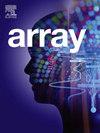Neighborhood Information Aggregation and Multi-View Feature Extraction-Based Contrastive Graph Clustering
IF 4.5
Q2 COMPUTER SCIENCE, THEORY & METHODS
引用次数: 0
Abstract
In recent years, graph contrastive clustering has received increasing attention in the field of graph deep clustering and achieved very excellent performance. Although graph contrast clustering has shown significant results in this field, most of the existing methods rely on manually designed data enhancement strategies. While these strategies perform well on image data, they often tend to lead to semantic drift when used on graph-structured data, thus limiting the performance of the model. In addition, existing methods mainly rely on the original graph topology information and fail to fully utilize the neighborhood information hidden in the node attribute features. To address the above problems, we proposes a Neighborhood Information Aggregation and Multi-View Feature Extraction-Based Contrastive Graph Clustering (NIA-MVFE-CGC) framework, which improves the existing methods from the perspectives of network architecture, feature redundancy and neighborhood information. First, We directly use multiple multilayer perceptrons (MLPs) to generate multiple views instead of using data augmentation methods. Secondly we utilize mutual information to reduce the redundancy between feature dimensions. Then, we design a neighborhood information aggregation module for mining the neighborhood information relationships of the samples. This module not only considers the explicit structures in the data, but also generates a new neighborhood relationship graph by combining the learned potential relationship structures. In addition, we design a weight graph that allows the model to adaptively adjust the proximity between samples during the learning process. Extensive experiments on five benchmark datasets show that our proposed method outperforms most other clustering algorithms.
基于邻域信息聚合和多视图特征提取的对比图聚类
近年来,图对比聚类在图深度聚类领域受到越来越多的关注,并取得了非常优异的性能。尽管图对比聚类在该领域已经取得了显著的成果,但现有的方法大多依赖于人工设计的数据增强策略。虽然这些策略在图像数据上表现良好,但在图结构数据上使用时往往会导致语义漂移,从而限制了模型的性能。此外,现有方法主要依赖于原始图拓扑信息,未能充分利用隐藏在节点属性特征中的邻域信息。针对上述问题,本文提出了一种基于邻域信息聚合和多视图特征提取的对比图聚类框架(NIA-MVFE-CGC),从网络结构、特征冗余度和邻域信息三个方面对现有方法进行了改进。首先,我们直接使用多个多层感知器(mlp)来生成多个视图,而不是使用数据增强方法。其次,利用互信息减少特征维度之间的冗余。然后,我们设计了一个邻域信息聚合模块来挖掘样本的邻域信息关系。该模块不仅考虑了数据中的显式结构,而且结合学习到的潜在关系结构生成新的邻域关系图。此外,我们设计了一个权重图,允许模型在学习过程中自适应调整样本之间的接近度。在五个基准数据集上的大量实验表明,我们提出的方法优于大多数其他聚类算法。
本文章由计算机程序翻译,如有差异,请以英文原文为准。
求助全文
约1分钟内获得全文
求助全文

 求助内容:
求助内容: 应助结果提醒方式:
应助结果提醒方式:


